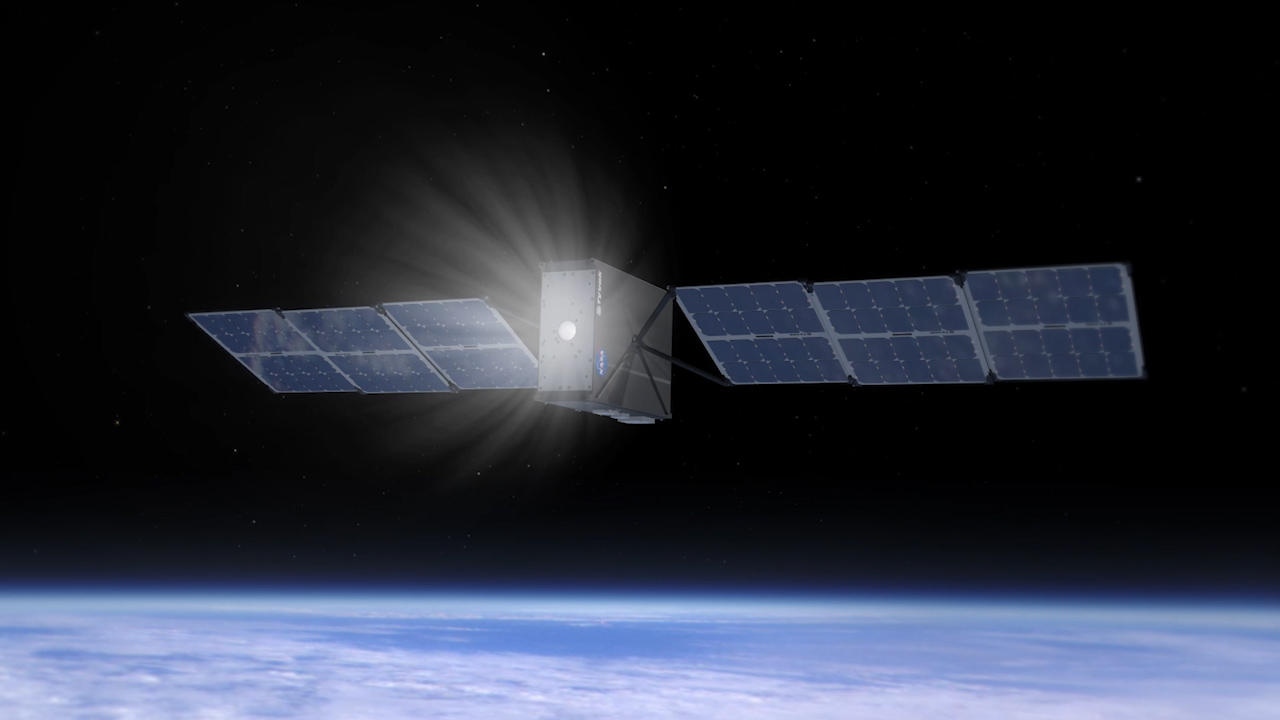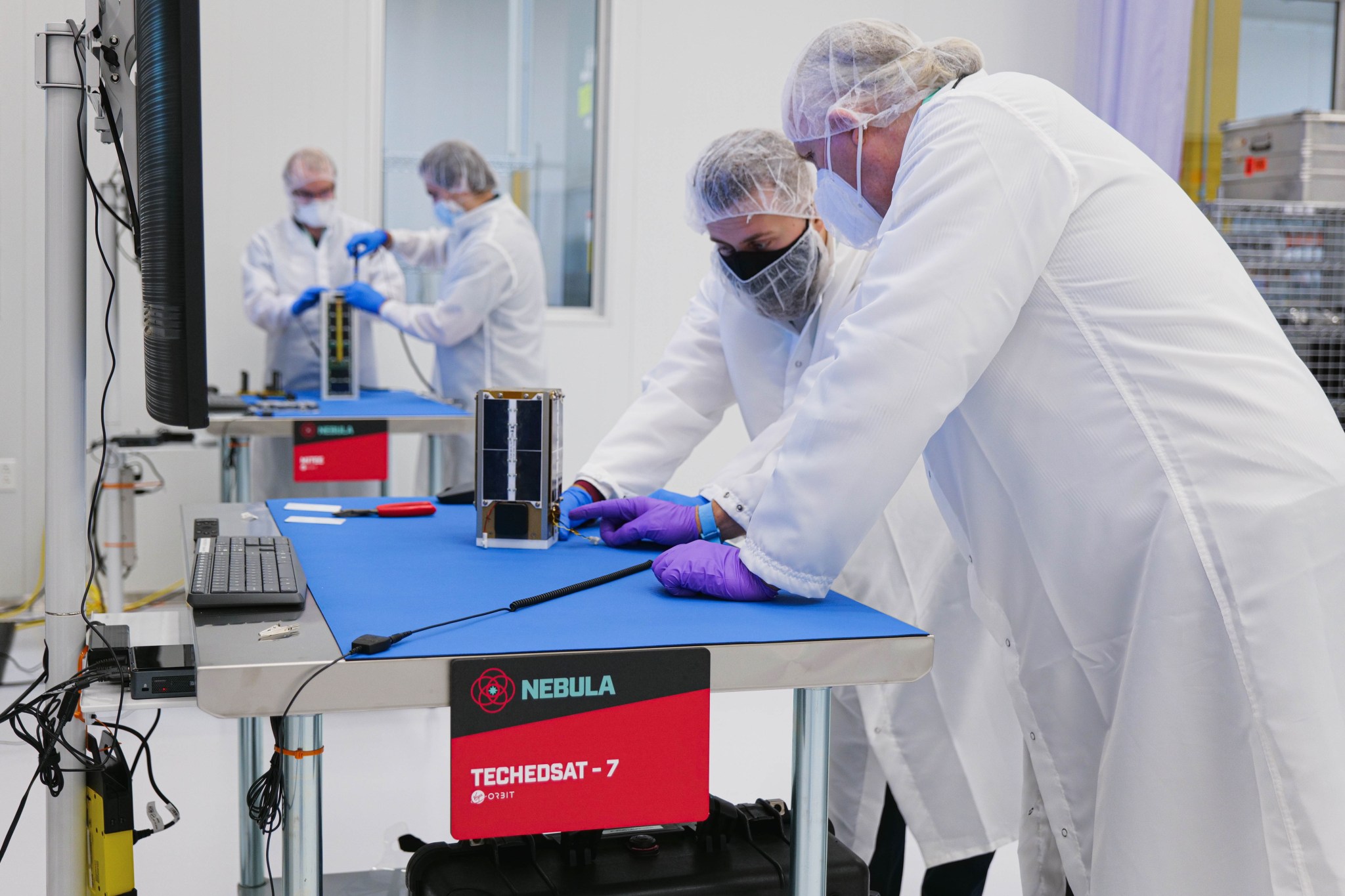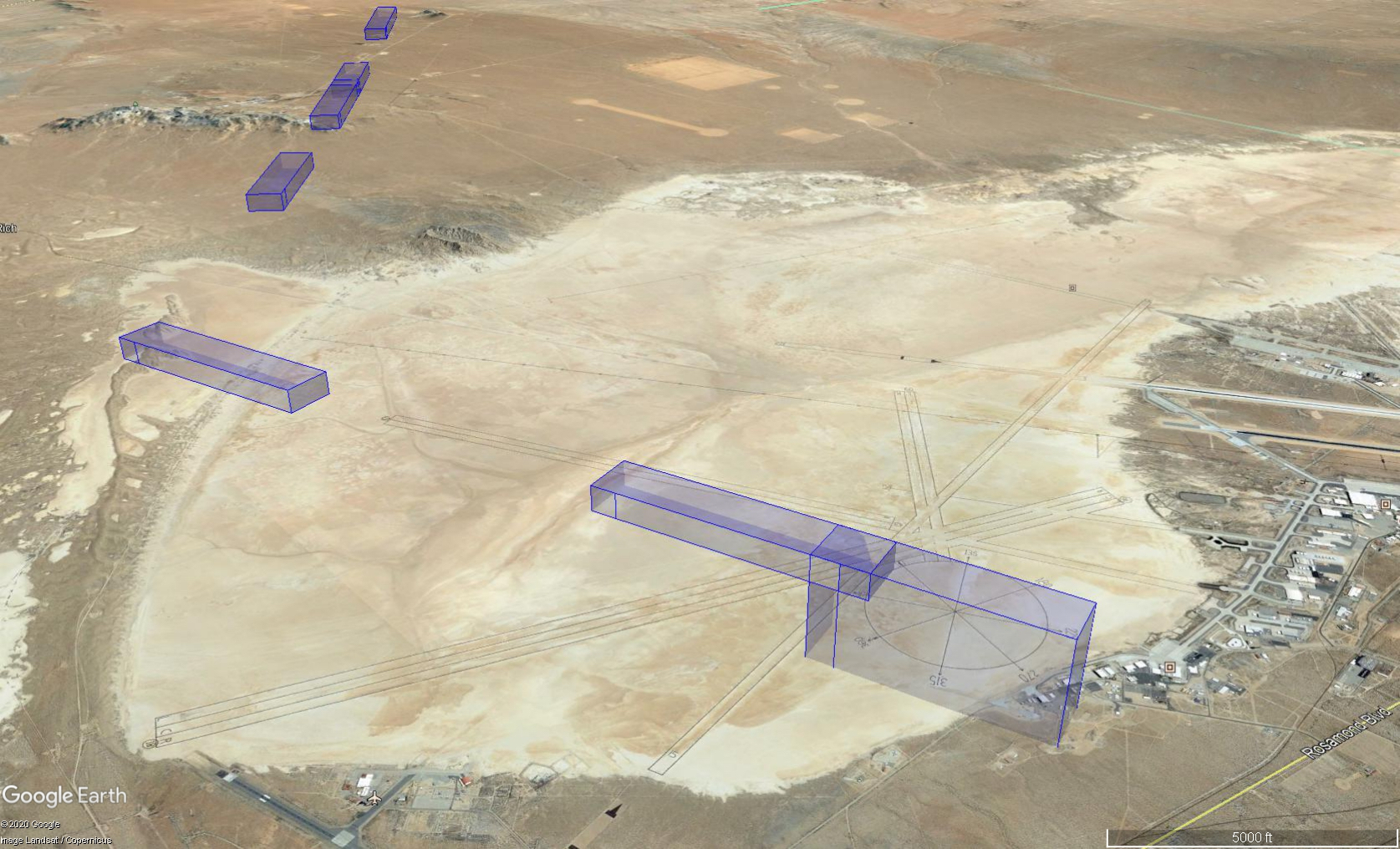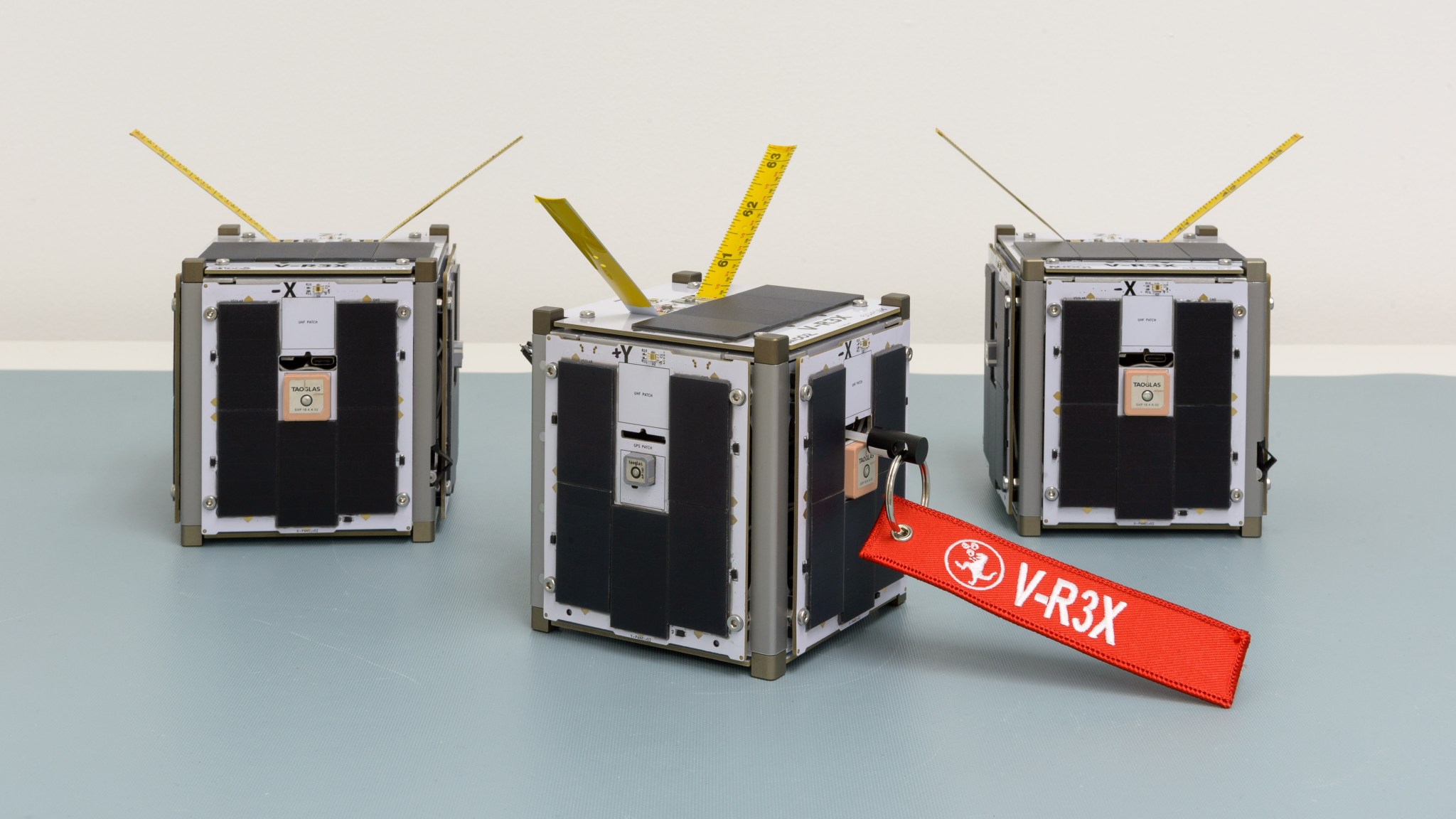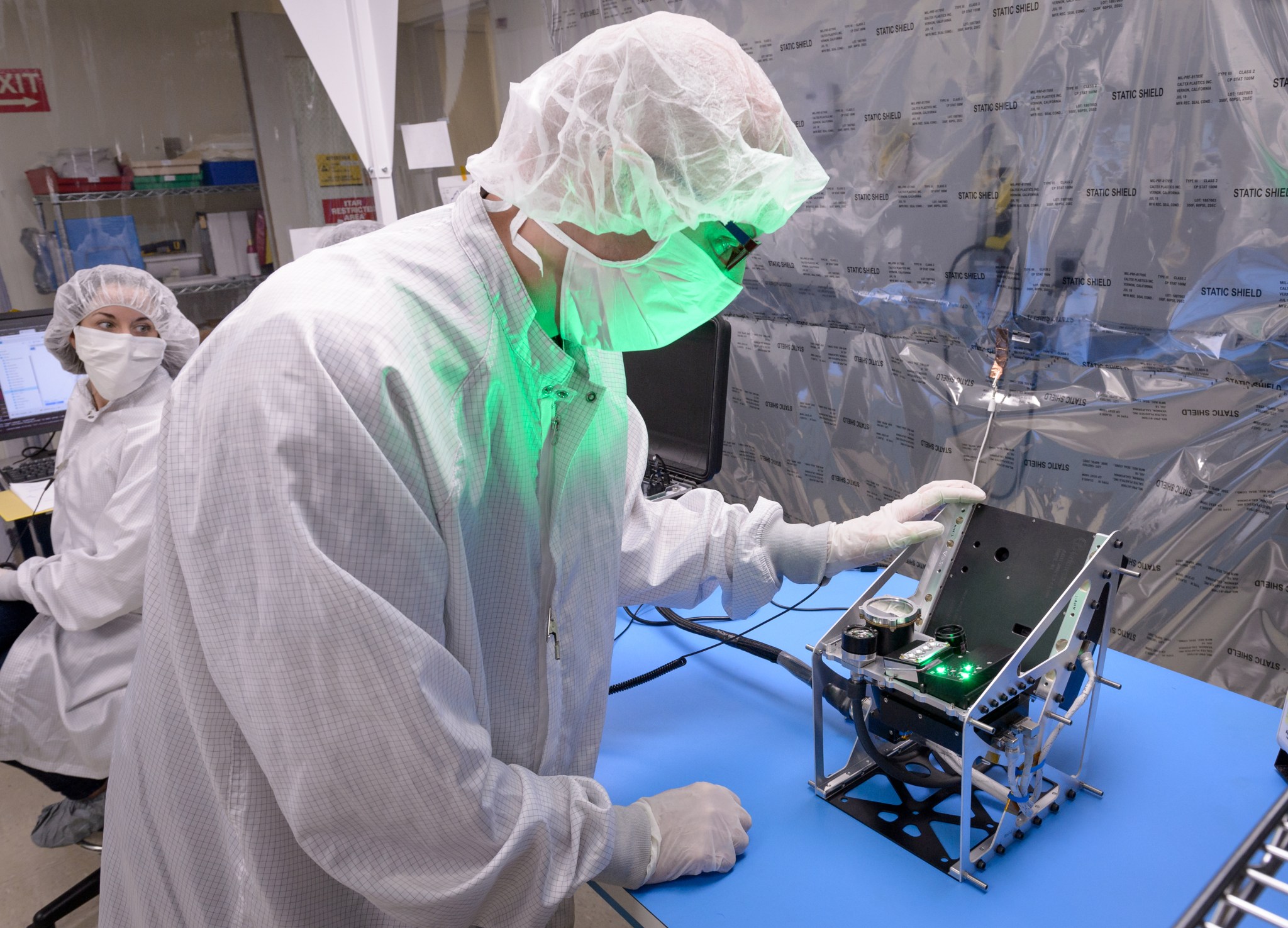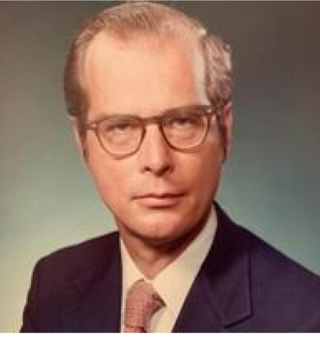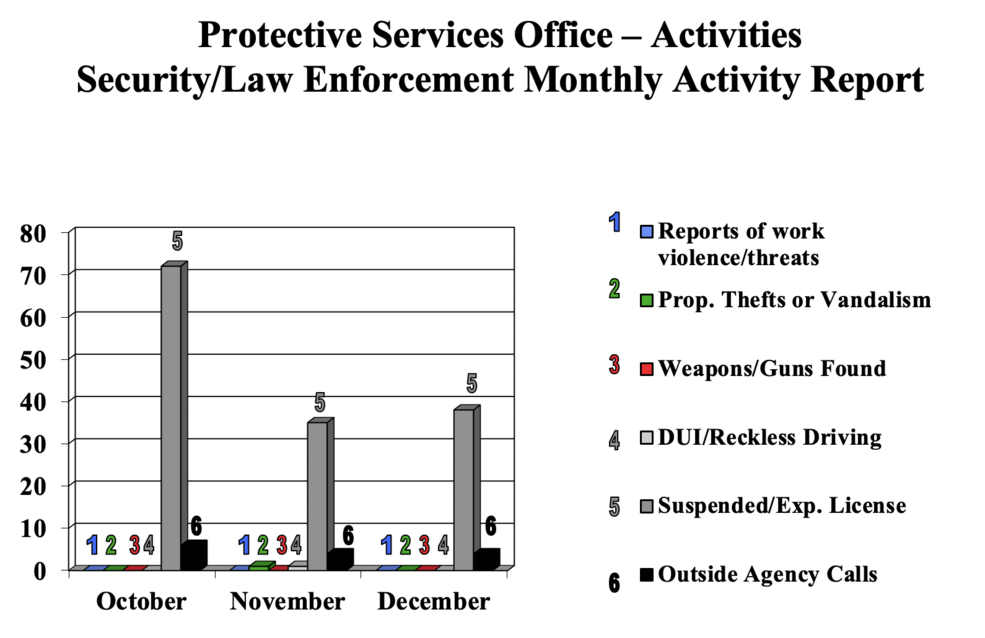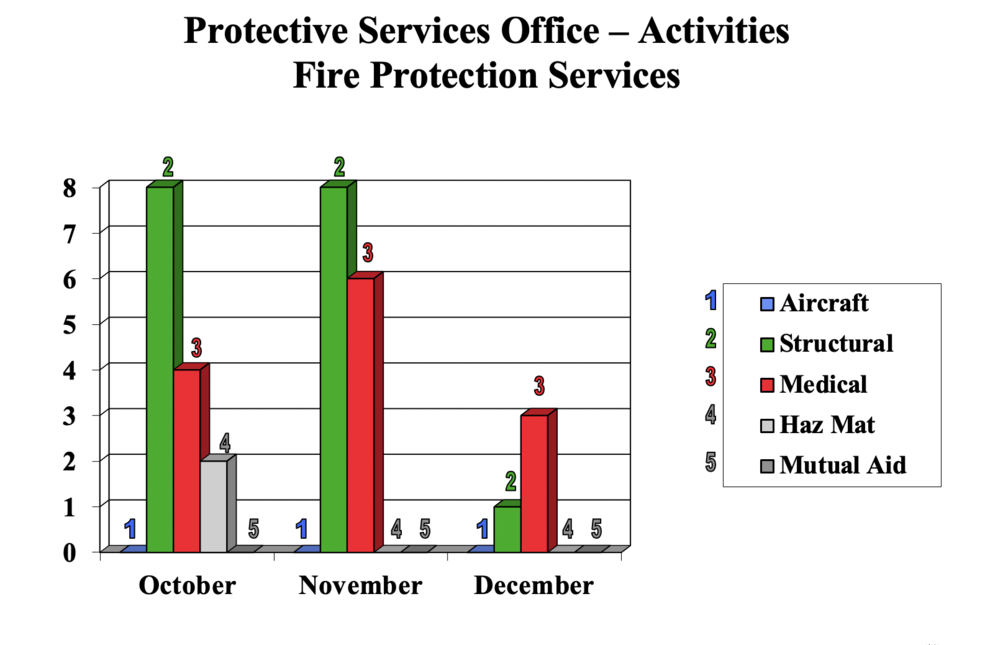NASA CubeSat to Demonstrate Water-Fueled Moves in Space
by Gianine Figliozzi
A NASA CubeSat will launch into low-Earth orbit to demonstrate a new type of propulsion system. Carrying a pint of liquid water as fuel, the system will split the water into hydrogen and oxygen in space and burn them in a tiny rocket engine for thrust.
NASA’s Pathfinder Technology Demonstrator, or PTD, series of missions demonstrates novel CubeSat technologies in low-Earth orbit, providing significant enhancements to the performance of these small and effective spacecraft. The first mission of the series, PTD-1, is slated to launch this month aboard a SpaceX Falcon 9 rocket on the Transporter-1 mission from Cape Canaveral Air Force Station in Florida.
“We have a driving need for small spacecraft propulsion systems,” said David Mayer, PTD-1 project manager at NASA’s Ames Research Center in California’s Silicon Valley. “The need is for many reasons: to reach a destination, maintain orbit, maneuver around other objects in space, or hasten de-orbit, helping spacecraft at end-of-life, to be good stewards of an increasingly cluttered space environment.”
This addresses a major concern, as spacecraft can become orbital debris at the end of their missions. The longer defunct spacecraft stay in orbit, the greater chance of spacecraft-to-spacecraft collision, creating more debris.
Water as Fuel
The choice of fuel used in spacecraft propulsion systems can come with serious safety precautions. Traditional, high-performance fuels pose risks, including toxicity, flammability, and volatility. The use of such rocket fuels for in-space propulsion systems require extensive safety measures, and this drives up mission cost.
“To make these propulsion systems feasible for CubeSats, good propulsive performance needs to be balanced by safety,” said Mayer. “PTD-1 will meet this need with the first demonstration of a water-based electrolysis spacecraft propulsion system in space.”
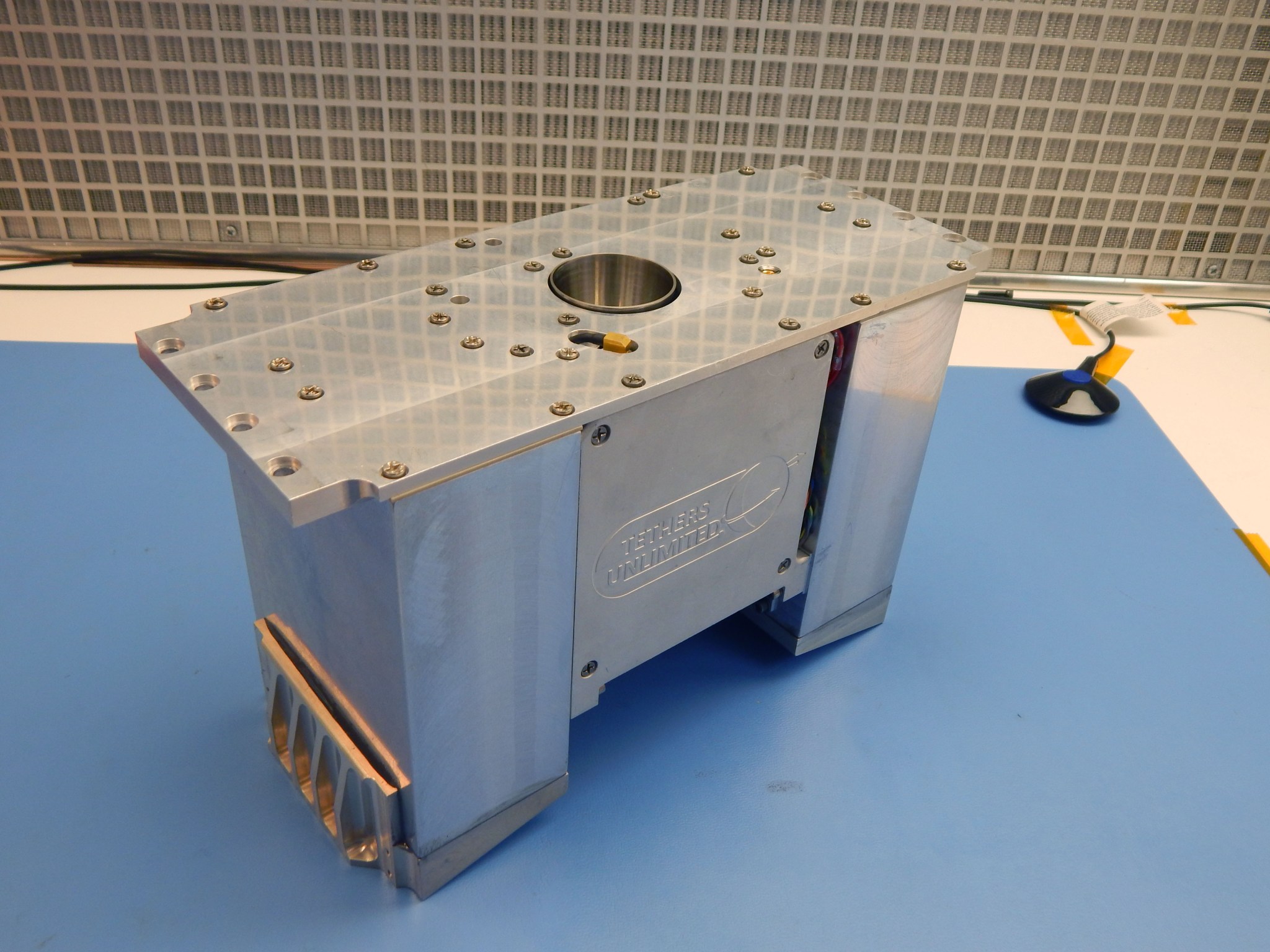
PTD-1’s propulsion system will produce gas propellants – a mix of hydrogen and oxygen – from water, only when activated in orbit. The system applies an electric current through water to chemically separate water molecules into hydrogen and oxygen gases, in a process called electrolysis. The CubeSat’s solar arrays harness energy from the Sun to supply the electric power needed to operate the miniature electrolysis system.
These gases are more energetic fuels than water; burning hydrogen and oxygen gas in a rocket nozzle generates more thrust than using “unsplit” liquid water as propellant. This strikes a better balance between performance and safety for spacecraft propulsion, meaning CubeSats will get more bang for the buck.
“What’s new is that this system uses water as the fuel in an energetic way, with an inherently safe system,” said Mayer. “This mission will show that we can use water electrolysis in a rocket engine in space – that’s pretty cool.”
Water is an inexpensive “green” resource for propulsion, non-toxic and stable. Green propellants like water are easier to handle, cheaper to obtain, and safer to integrate into spacecraft.
“We are disallowed from using high-performance propulsion systems in CubeSats because of the nature of how we launch these missions, namely by being attached to other spacecraft,” said Mayer.
Most CubeSats and other small spacecraft launch to space as secondary payloads, often riding to space alongside larger and more expensive payloads. The use of traditional “high-performance” rocket fuels for CubeSat propulsion systems are avoided because the onboard presence of such fuels would increase mission risk to other payloads and the launch vehicle. The inability to use these fuels limits performance for small spacecraft propulsion systems.
“Water is the safest rocket fuel I know of,” said Mayer.
A Low-Cost, Effective Propulsion System
The PTD-1 spacecraft is a 6-unit CubeSat, comparable in size to a shoebox. Its flight demonstration, lasting four to six months, will verify propulsion performance through programmed changes in spacecraft velocity and altitude executed by the water-fueled thrusters. The mission will show that this safe, low-cost, high-performance propulsion system works in space and will pave the way for operational small spacecraft missions.
Flight qualification and demonstration of this technology increases small spacecraft mobility and capability for use in future science and exploration missions. This technology could be applied in future deep-space missions using water resources found off Earth such as from comets or the Moon and Mars.
The propulsion system, named Hydros, was developed by Tethers Unlimited, Inc., in Bothell, Washington. This technology was initially developed under a NASA Small Business Innovation Research contract and then matured under a NASA Tipping Point partnership. The PTD spacecraft bus was developed by Tyvak Nano-Satellite Systems, Inc., in Irvine, California. Tyvak is also performing payload integration and operations for the PTD-1 mission.
NASA’s Ames Research Center in California’s Silicon Valley manages the PTD series. NASA’s Glenn Research Center in Cleveland collaborates as the payload lead on the PTD-1 mission. The mission launches as part of NASA’s Educational Launch of Nanosatellites 35, funded by NASA’s Advanced Exploration Systems division of Human Exploration and Operations Mission Directorate. The PTD mission is managed and funded by the Small Spacecraft Technology program within the NASA’s Space Technology Mission Directorate.
TechEdSat-7’s Flight Mission Begins
by Gianine Figliozzi
On Jan. 17, 2021, TechEdSat-7 deployed into low-Earth orbit from Virgin Orbit’s LauncherOne rocket at an altitude of 310 miles – about 60 miles higher than the International Space Station’s orbit. This 2-unit CubeSat will test technologies over the mission’s approximately 12 months of spaceflight. TechEdSat-7 was one of nine CubeSat missions on Virgin Orbit’s Launch Demo 2 as part of NASA’s 20th Educational Launch of Nanosatellites mission.
TechEdSat-7 is one of a series of nanosatellite flight missions developed and managed by NASA’s Ames Research Center in California’s Silicon Valley. Each mission of the series helps to teach a new generation of researchers and engineers how to execute meaningful, rapid-flight experiments. These missions test cutting-edge technologies relevant to the overall goal of using cost-effective CubeSats to bring small payloads from orbit back to Earth or to the surface of other worlds, such as Mars.
Technologies packed into TechEdSat-7 include a novel exo-brake, a deployable device that applies drag to the spacecraft to cause deorbit. This technology could have the application of selectively acting as a space “junk hauler” by dragging debris out of orbit. A CubeSat that can rendezvous with a piece of debris and subsequently deploy a large exo-brake can more rapidly dispose of the pair by entering Earth’s atmosphere.
TechEdSat-7 also tests a new generation of electronic components, and collects data about the effectiveness of using a commercial satellite constellation as a means to more quickly command and control nanosatellites. In addition, TechEdSat-7 conducts an experiment in order to both help identify nanosatellites, and also to allow optical ground stations to practice operations for upcoming communication systems.
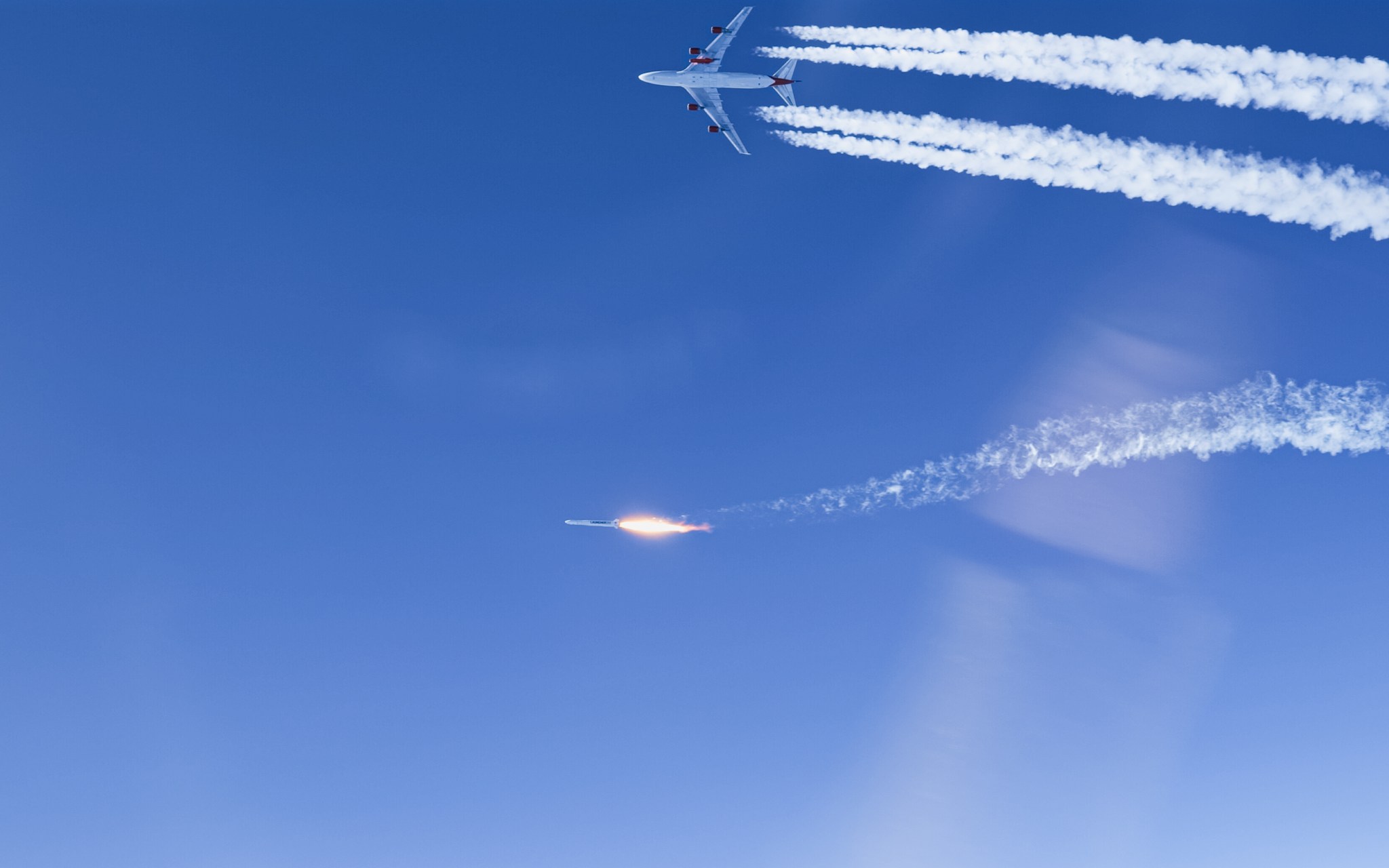
Students from the International Space University in Illkirch-Graffenstaden, France, San Jose State University in San Jose, California, University of Florida in Gainesville, Florida, University of Idaho in Moscow, Idaho, and Smith College in Northampton, Massachusetts, contribute to TechEdSat-7’s mission.
The TechEdSat-7 mission is supported by NASA’s Small Spacecraft Technology program and the Entry System Modeling project, both funded by NASA’s Space Technology Mission Directorate. Additional support is provided by the Engineering Directorate at Ames. TechEdSat-7’s launch was provided by NASA’s CubeSat Launch Initiative and was managed by the Launch Services Program at NASA’s Kennedy Space Center in Florida.
Small satellites, including CubeSats, provide a low-cost platform for scientific research, technology demonstrations, and educational investigations. NASA’s small satellite initiatives develop missions to observe Earth, study the Moon, and test advanced instruments like high-bandwidth laser communications and autonomous navigation. NASA also funds rideshare launch opportunities for small satellites, including student projects. With this increased access to space, students can gain hands-on experience in satellite development and operations.
NASA Sets Stage for Future Flights, Auditions Advanced Air Mobility Technologies
by Rachel Hoover
As any performer knows, it’s important to rehearse, rehearse, and – when you think you’re ready – rehearse some more. Similarly, before air taxis, cargo transport, and package-delivery drones take to the sky, airspace service providers must practice their scripts … software programming scripts, that is. And NASA has the virtual stage to do just that.
Setting the Stage
The Air Traffic Management Exploration, or ATM-X, team is providing the virtual environment for third-party airspace service providers to rehearse their technology capabilities and ensure future Advanced Air Mobility vehicles or electric-powered vertical takeoff and landing vehicles can safely integrate with existing and future air traffic. The goal of the ATM-X project is to accelerate the development of software that is robust and integrated enough to increase automation and avoid adding additional challenges for national airspace traffic controllers.
NASA’s vision for the Advanced Air Mobility National Campaign is to help create safe, sustainable, accessible, and affordable aviation for a number of uses at local and regional levels. NASA and the Federal Aviation Administration intend to collaborate throughout all stages of the National Campaign, from planning and scenario validation, to flight demonstrations and simulation activities.
“The space where these aircraft will operate is sandwiched between low-flying drones and the traditional airspace high above,” said Savvy Verma, lead for airspace procedures and design for the Urban Air Mobility subproject in ATM-X at NASA’s Ames Research Center in California’s Silicon Valley. “Aircraft flying in these layers will interact, and that’s where things get tricky.”
By leveraging NASA’s innovative Unmanned Aircraft Systems Traffic Management, or UTM, system and partnering with a group of airspace service providers and the FAA, the team has been collaboratively developing, testing, and evaluating this burgeoning flight environment to ensure they are ready for flight tests, which recently began. By integrating third-party airspace service providers’ technologies and virtually testing them in a simulation prior to deploying the system in the field, engineers are able to evaluate how well providers can communicate with each other and adapt to different flight scenarios in simulated environments with interactive data visualizations, including other simulated aircraft.
The Show Must Go On
Even though the team, like many workers across the globe, switched to remote work in response to the global pandemic in 2020, they were able to continue tests as-planned in a virtual setting. Typically, the team would use the Air Traffic Control Simulation Laboratory at Ames, but the team adapted the tests and were able to connect virtually and remotely run operations.
“A key characteristic of this system is cooperatively working with many airspace industry partners to evaluate their current capabilities and focus on the mechanisms for how taxi operators will communicate with each other and the FAA,” said Spencer Monheim, lead for airspace integration, testing, and development for the Urban Air Mobility subproject in ATM-X at Ames. “While using the NASA-developed UTM, we’re really seeking community feedback for the software infrastructure that will support these kinds of operations.”
In parallel to the X3 simulation activities, NASA began conducting a series of flight tests in December called the National Campaign Dry Run. This series uses a helicopter as a representative vehicle to develop an analytical baseline for comparison with future industry vehicle flight testing. In addition, these flight tests are key to evaluating flight test infrastructure, which consists of range safety, vehicle instrumentation, airspace integration, weather sensors and data collection, dissemination, storage, and analysis capabilities.
X4: The Sequel
X3 is a foundational step in establishing the technology, infrastructure, and information needed for X4 – the next lab evaluation activity for the ATM-X team and its partners – before the first National Campaign test, NC-1. X4 will advance the technology and test new information sharing requirements – amongst providers, as well as between providers and air traffic controllers – to enable safe, efficient urban air mobility operations while staying aware of increasing demands on the airspace. The team will support the National Campaign Developmental Test in 2021, and NC-1 in 2022. For NC-1, industry partners will focus on demonstrating integrated operations through flight activities with vehicles and third-party airspace service providers at various locations in the National Airspace System around the country.
Over the next decade, NASA will work to determine how cities, airports, and overall infrastructure can support this type of passenger transport and cargo delivery. The data and lessons learned from the National Campaign will help inform FAA policies and procedures that industry will follow as they fly various-size vehicles and diverse missions. In addition, demonstrations will enable communities and local governments to further understand operations and assess the noise footprint of these new vehicles.
This project includes members from four NASA aeronautics centers, including Armstrong Flight Research Center in Edwards, California; Ames Research Center in California’s Silicon Valley; Langley Research Center in Hampton, Virginia; as well as Glenn Research Center in Cleveland, with leadership by NASA’s Aeronautics Research Mission Directorate.
Swarming Small Satellites to Develop the Next Generation of Communication and Navigation Tech
by Frank Tavares
Learning how to communicate and navigate multiple spacecraft autonomously in space is a technology challenge that will become even more important to solve as NASA continues to operate in low-Earth orbit and beyond. The V-R3x mission uses a swarm of three small satellites to demonstrate new technologies and techniques for radio networking and navigation. By developing and demonstrating these technologies on a small scale, they can be implemented for future multi-spacecraft missions, enabling NASA to pursue its future science, technology, and exploration goals.
Using three satellites known as CubeSats, each about the size of a coffee mug, the mission will conduct a series of such demonstrations. They will prove the ability to take high-precision data on spacecraft distance, send data from one spacecraft to the other at a high data rate, coordinate radiation measurements using onboard sensors, and keep track of the orientation and formation of all three spacecraft.
The first stage of the mission will begin with an orbital mission launching aboard a SpaceX Falcon 9 rocket as a part of the Transporter-1 mission. If all goes according to plan, the mission anticipates completing its primary objectives within two weeks of launch, with a full mission duration of three months to gather additional data.
To complement this launch, the V-R3x team will also launch a CubeSat on a high-altitude balloon in the future. The balloon test is facilitated via NASA’s Flight Opportunities program. Four units will be deployed on the ground, each driven to separate locations. Once turned on, each unit will communicate with the satellite at the upper edges of the atmosphere – over 100,000 feet away.
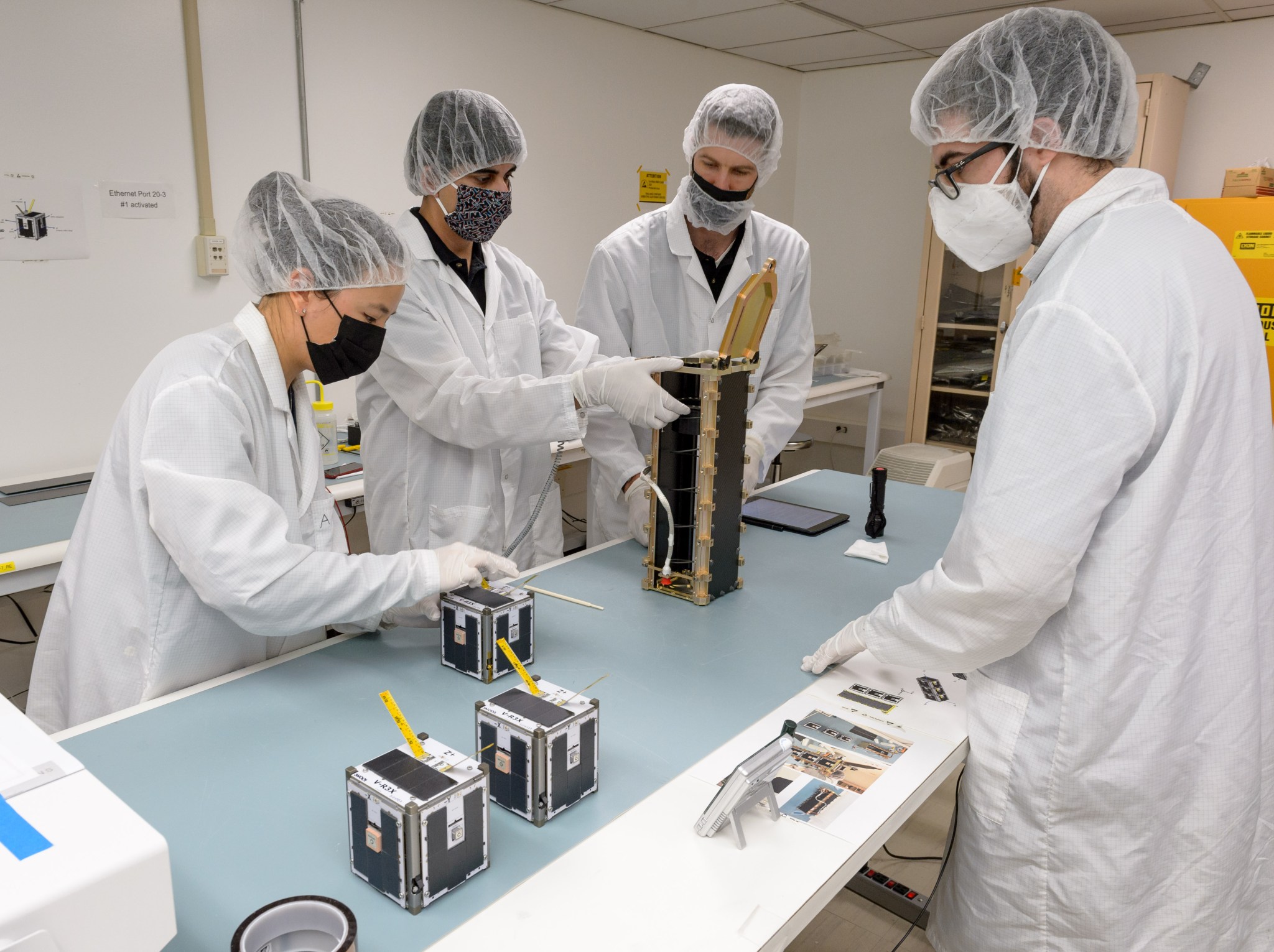
Both experiments will show the ability for small satellites to be in communication with each other across vast distances, maintain spatial awareness relative to each other, coordinate to collect data, and speedily share that data with each other.
V-R3x is based on an open-source CubeSat framework that integrates hardware and software, known as PyCubed. It will also be making use of the Amazon Web Service’s ground station, the first operational use case for a NASA mission. Going forward, V-R3x provides NASA a simple, low-cost platform for future technology demonstration needs.
Milestones:
- January 2021: V-3Rx will be launching as a secondary payload aboard SpaceX Transporter-1, launching at Cape Canaveral Air Force Station in Florida.
- February 2021: A high-altitude balloon test campaign will be conducted with Raven Aerostar in Baltic, South Dakota, to complement the orbital mission.
Collaborators:
The V-R3x project is a collaboration between the Payload Accelerator for CubeSat Endeavors initiative, or PACE, at NASA’s Ames Research Center in California’s Silicon Valley and the Robotic Exploration Lab, or REx. PACE is a part of the Small Spacecraft Technology program within NASA’s Space Technology Mission Directorate. REx was previously at Stanford University in California and is now based at the Robotics Institute at Carnegie Mellon University in Pittsburgh, Pennsylvania. The Flight Opportunities program, based at NASA’s Armstrong Flight Research Center in Edwards, California, facilitates rapid demonstration of space technologies through suborbital testing with industry flight providers.
Planetary Sleuthing Finds Triple-Star World
by Alison Hawkes
Shortly after NASA’s Kepler mission began operations back in 2009, the space telescope spotted what was thought to be a planet about half the size of Saturn in a multiple-star system. KOI-5Ab was only the second planet candidate to be found by the mission, and exciting as it was at the time, it was ultimately set aside as Kepler racked up more and more planet discoveries.
By the end of the spacecraft’s operations in 2018, Kepler had discovered a whopping 2,394 exoplanets, or planets orbiting stars beyond our sun, and an additional 2,366 exoplanet candidates that would still need confirmation.
“KOI-5Ab got abandoned because it was complicated, and we had thousands of candidates,” said David Ciardi, chief scientist of NASA’s Exoplanet Science Institute. “There were easier pickings than KOI-5Ab, and we were learning something new from Kepler every day, so that KOI-5 was mostly forgotten.”
Now, after a lengthy hunt that spanned many years and many telescopes, Ciardi said he has “resurrected KOI-5Ab from the dead.” Thanks to new observations from NASA’s second planet-hunting mission, the Transiting Exoplanet Survey Satellite, or TESS, and a number of ground-based telescopes, Ciardi was finally able to untangle all the evidence surrounding KOI-5Ab and prove its existence. There are some intriguing details about it to mull over.
Most likely a gas giant planet like Jupiter or Saturn in our solar system given its size, KOI-5Ab is unusual in that it orbits a star in a system with two other companion stars, circling on a plane that’s out of alignment with at least one of the stars. The arrangement calls into question how each member in this system formed out of the same swirling clouds of gas and dust. Ciardi, who is located at Caltech in Pasadena, California presented the findings at a virtual meeting of the American Astronomical Society.
“We don’t know of many planets that exist in triple-star systems, and this one is extra special because its orbit is skewed,” said Ciardi. “We still have a lot of questions about how and when planets can form in multiple-star systems and how their properties compare to planets in single-star systems. By studying this system in greater detail, perhaps we can gain insight into how the universe makes planets.”
Picking up the trail After its initial detection by Kepler, Ciardi and other researchers picked up the trail on KOI-5Ab as part of a cache of planet candidates they were following up on. Using data from the W. M. Keck Observatory in Hawaii, Caltech’s Palomar Observatory near San Diego, and Gemini North in Hawaii, Ciardi and other astronomers determined that KOI-5b appeared to be circling one star in a triple-star system. However, they still couldn’t tease out whether the planet signal was actually an erroneous glitch from one of the two other stars, or, if the planet was real, which of the stars it orbited.
Then, in 2018, TESS came along. Like Kepler, TESS looks for the blinking of starlight that comes when a planet crosses in front of, or transits, a star. TESS observed a portion of Kepler’s field of view, including the KOI-5 system. Sure enough, TESS also identified KOI-5Ab as a candidate planet, though TESS calls it TOI-1241b. As Kepler had observed previously, TESS found that the planet orbited its star roughly every five days.
“I thought to myself, ‘I remember this target,’” said Ciardi, after seeing the TESS data. “But we still couldn’t determine definitively if the planet was real or if the blip in the data came from another star in the system – it could have been a fourth star.”
Clues in the wobbles He then went back and re-analyzed all the data, and then searched for new clues from ground-based telescopes. Deploying an alternate technique to Kepler and TESS, the Keck Observatory is often used for follow-up searches of exoplanets by measuring the slight wobble in a star as a planet circles around it and exerts a gravitational tug. Ciardi, teaming up with other scientists through an exoplanet collaboration group called the California Planet Search, looked for any wobbles in Keck’s data on the KOI-5 system. They were able to tease out a wobble produced by the inner companion star orbiting the primary star from the wobble of the apparent planet as it orbits the primary star. Together, the different collections of data from the space- and ground-based telescopes helped confirm that KOI-5Ab is, indeed, a planet orbiting the primary star.
“Bingo – it was there! If it weren’t for TESS looking at the planet again, I would never have gone back and done all this detective work,” he said. “But it truly did take a lot of sleuthing within data collected from many different telescopes to finally nail down this planet.”
KOI-5Ab orbits Star A, which has a relatively close companion, Star B. Star A and Star B orbit each other every 30 years. A third gravitationally bound star, Star C, orbits stars A and B every 400 years.
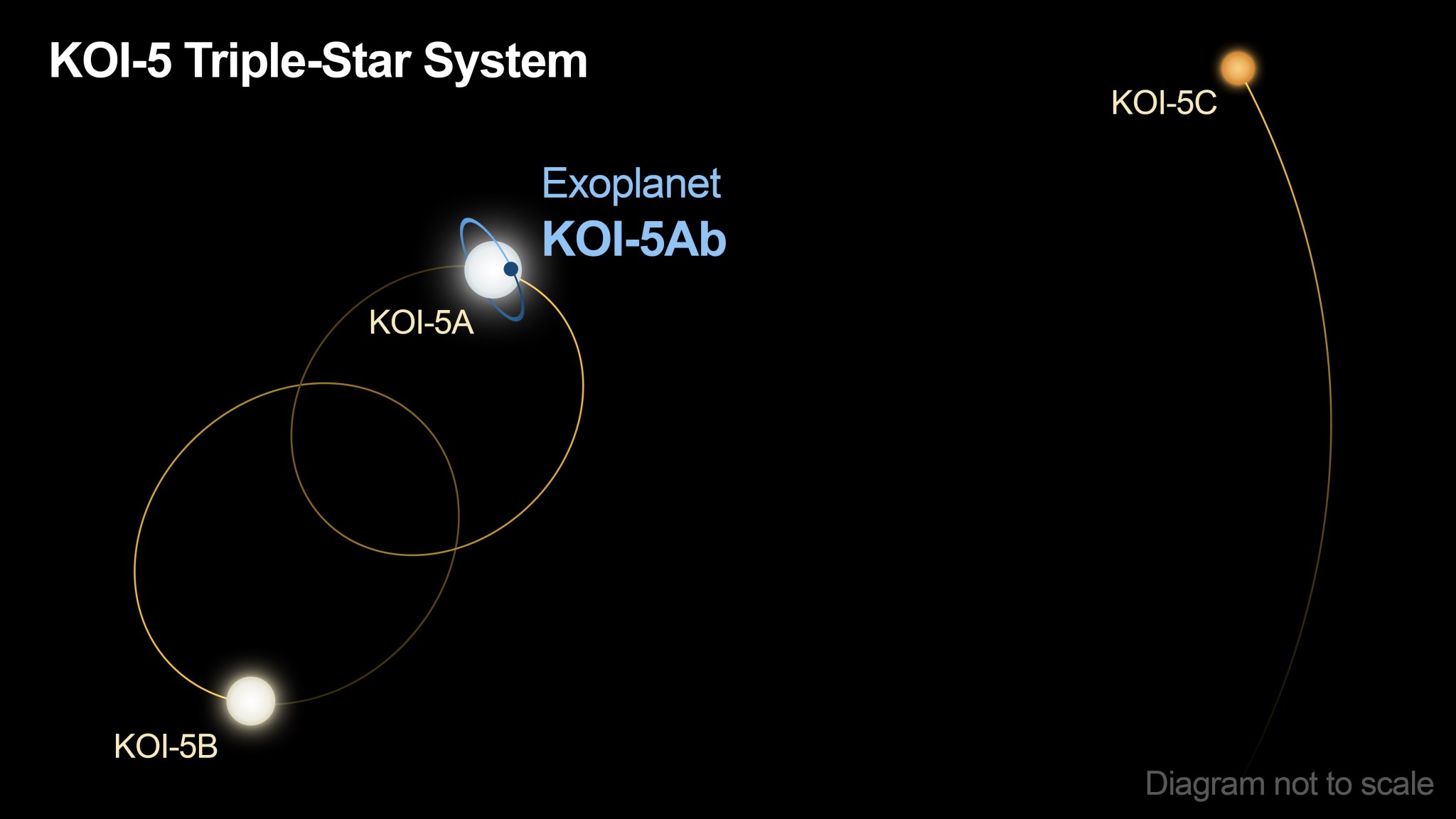
A skewed orbit The combined data set also reveals that the orbital plane of the planet is not aligned with the orbital plane of Star B, the second inner star as might be expected if the stars and planet all formed from the same disk of swirling material. Astronomers are not sure what caused the misalignment of KOI-5Ab but believe that the second star gravitationally kicked the planet during its development, skewing its orbit and causing it to migrate inward. Triple-star systems make up about 10% of all star systems.
This is not the first evidence of planets in double- and triple-star systems. One striking case involves the triple-star system GW Orionis, in which a planet-forming disk has been torn into distinct, misaligned rings, where planets may be forming. Yet despite hundreds of discoveries of planets in multiple-star system, far fewer planets have been observed than in single-star systems. This could be due to an observational bias (single-star planets are easier to detect), or because planet formation is in fact less common in multiple-star systems.
“This research emphasizes the importance of NASA’s full fleet of space telescopes and their synergy with ground-based systems,” said Jessie Dotson, the project scientist for the Kepler space telescope at NASA’s Ames Research Center in California’s Silicon Valley. “Discoveries like this one can be a long haul.”
New and future instruments, such as the Palomar Radial Velocity Instrument at the 200-inch Hale Telescope at Palomar, the NASA and National Science Foundation’s NEID instrument in southern Arizona, and the Keck Planet Finder will open up new avenues for learning about exoplanets.
The Ames 2020 CFC, We Give Because We Care – Let’s Show Some Love, Ames!
by Harry Jackson, Ames CFC Campaign Manager
It’s time to Show Some Love! This year’s Combined Federal Campaign, or CFC, ends on Jan. 15. You’re invited to join the hundreds of thousands in the federal community who pledge through the CFC year after year.
Not sure what the CFC is or how it works? On March 23, 1982, President Reagan issued executive order 12353 “Charitable Fundraising,” which created the modern CFC. One of the largest and most successful employee fundraising campaigns in the world, the CFC is the official workplace giving opportunity for the federal government. The mission of the campaign is to promote and support philanthropy through a program that is employee-focused, cost-efficient, and effective in providing federal employees the opportunity to improve the quality of life for all.
The CFC allows federal employees, contractors, and retirees to combine efforts to raise money, volunteer, and “Show Some Love” to their favorite CFC-supported charities.
Ames is a leader among Bay Area federal agencies in generosity and support of the CFC. Ames has been the number one contributor in caring for others for a number of years within the Northern California CFC, covering 40 counties. We believe there is a direct correlation between the success of the campaign and management interest, involvement, and support.
Whether this is your first experience with the CFC or your fifteenth, it’s helpful to know your giving options. You can contribute financially to one or more charities of your choice through payroll deduction, credit card, and e-check. You can even pledge volunteer hours! So, please think about the cause(s) you want to support and how much you can give to help those in need.
Not sure how much to give to your favorite charity? Last year, the average gift in the Northern California CFC Zone was $577.00. Please consider whether you’re able to match or even exceed that amount. However you choose to give, every little bit makes a difference for those in need. Your pledge can be completed anonymously or with the release of your contact information to the charity you are supporting. This year’s fund-raising goal for 2020 is $220,000.
Please visit your Ames CFC Website at: https://cfc.arc.nasa.gov for a list of charities to find those with programs that support your chosen causes or contact your directorate CFC key workers for more information or if you need assistance designating your pledge. Let’s come together Ames and Show Some Love for our CFC charities and those they serve!
Cheers, and thank you for your support,
For additional information, contact Harry Jackson, Ames CFC Chief Coordinator or Bryan Biegel, Ames Deputy Chief Coordinator
Magnetic ‘Highway’ Channels Material Out of Cigar Galaxy
by Kassandra Bell
What’s fueling the massive ejection of gas and dust out of the Cigar galaxy, otherwise known as Messier 82?
We know that thousands of stars bursting into existence are driving a powerful super-wind that’s blowing matter into intergalactic space. New research shows that magnetic fields are also contributing to the expulsion of material from Messier 82, a well-known example of a starburst galaxy with a distinctive, elongated shape.
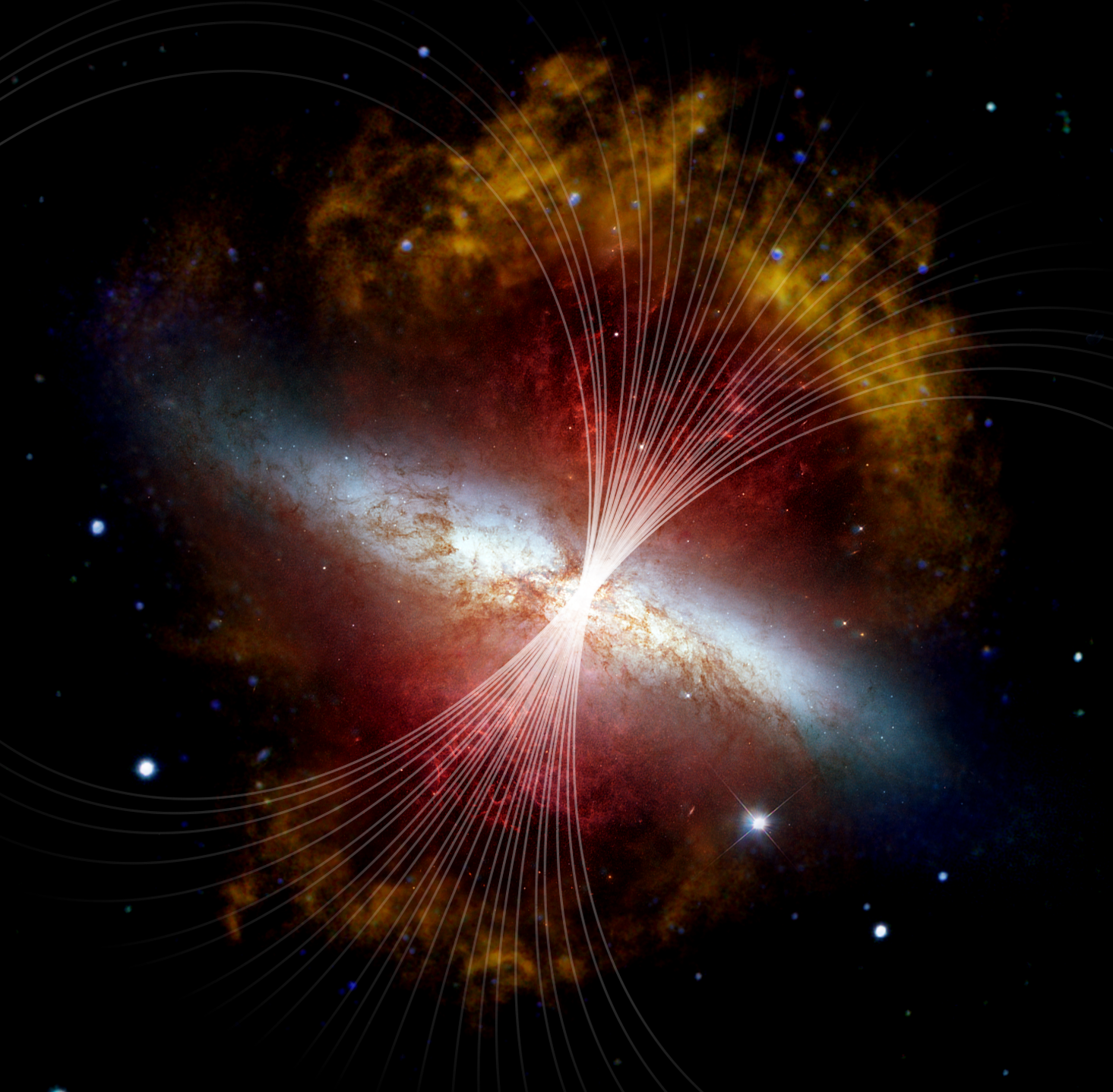
The findings from NASA’s Stratospheric Observatory for Infrared Astronomy, or SOFIA, help explain how dust and gas can move from inside galaxies into intergalactic space, offering clues to how galaxies formed. This material is enriched with elements like carbon and oxygen that support life and are the building blocks for future galaxies and stars. The research was presented at the meeting of the American Astronomical Society.
SOFIA, a joint project of NASA and the German Aerospace Center, DLR, previously studied the direction of magnetic fields close to the core of Messier 82, as the Cigar galaxy is officially known. This time the team applied tools that have been used extensively to study the physics around the Sun, known as heliophysics, to understand the magnetic field’s strength surrounding the galaxy at a distance 10 times larger than before.
“This is old physics for studying the Sun, but new for galaxies,” said Joan Schmelz, a director at the Universities Space Research Association based at NASA’s Ames Research Center in Silicon Valley, and co-author of the upcoming paper about this research. “It’s helping us understand how the space between stars and galaxies became so rich with matter for future cosmic generations.”
Located 12 million light-years from Earth in the constellation Ursa Major, the Cigar galaxy is undergoing an exceptionally high rate of star formation called a starburst. The star formation is so intense that it creates a “super wind” that blows material out of the galaxy. As SOFIA previously found using the instrumented called the High-Resolution Airborne Wideband Camera, or HAWC+, the wind drags the magnetic field near the galaxy’s core so that it’s perpendicular to the plane of the galaxy across 2,000 light-years.
Researchers wanted to learn if the magnetic field lines would extend indefinitely into intergalactic space like the magnetic environment in the solar wind, or turn over to form structures similar coronal loops that are found in active regions of the Sun. They calculate that the galaxy’s magnetic fields extend out like the solar wind, allowing the material blown by the super wind to escape into intergalactic space.
These extended magnetic fields may help explain how gas and dust spotted by space telescopes have traveled so far away from the galaxy. NASA’s Spitzer Space Telescope detected dusty material 20,000 lightyears beyond the galaxy, but it was unclear why it had spread so far away from the stars in both directions instead of in a cone-shaped jet.
“The magnetic fields may be acting like a highway, creating lanes for galactic material to spread far and wide into intergalactic space,” said Jordan Guerra Aguilera, a postdoctoral researcher at Villanova University in Pennsylvania and co-author on the upcoming paper.
With rare exceptions, the magnetic field in the solar corona cannot be measured directly. So, about 50 years ago, scientists developed methods to accurately extrapolate magnetic fields from the Sun’s surface into interplanetary space, known in heliophysics as the potential field extrapolation. Using SOFIA’s existing observations of central magnetic fields, the research team modified this method to estimate the magnetic field about 25,000 light-years around the Cigar galaxy.
“We can’t easily measure the magnetic fields at scales this large, but we can extrapolate it with these tools from heliophysics,” said Enrique Lopez-Rodriguez, a Universities Space Research Association scientist for SOFIA based at Ames and lead author on the study. “This new, interdisciplinary method gives us the larger perspective that we need to understand starburst galaxies.”
SOFIA is a joint project of NASA and the German Aerospace Center. NASA’s Ames Research Center in California’s Silicon Valley manages the SOFIA program, science, and mission operations in cooperation with the Universities Space Research Association, headquartered in Columbia, Maryland, and the German SOFIA Institute at the University of Stuttgart. The aircraft is maintained and operated by NASA’s Armstrong Flight Research Center Building 703, in Palmdale, California. The High-Resolution Airborne Wideband Camera instrument was developed and delivered to NASA by a multi-institution team led by NASA’s Jet Propulsion Laboratory.
Magnetic Chaos Hidden Within the Whirlpool Galaxy
by Kassandra Bell
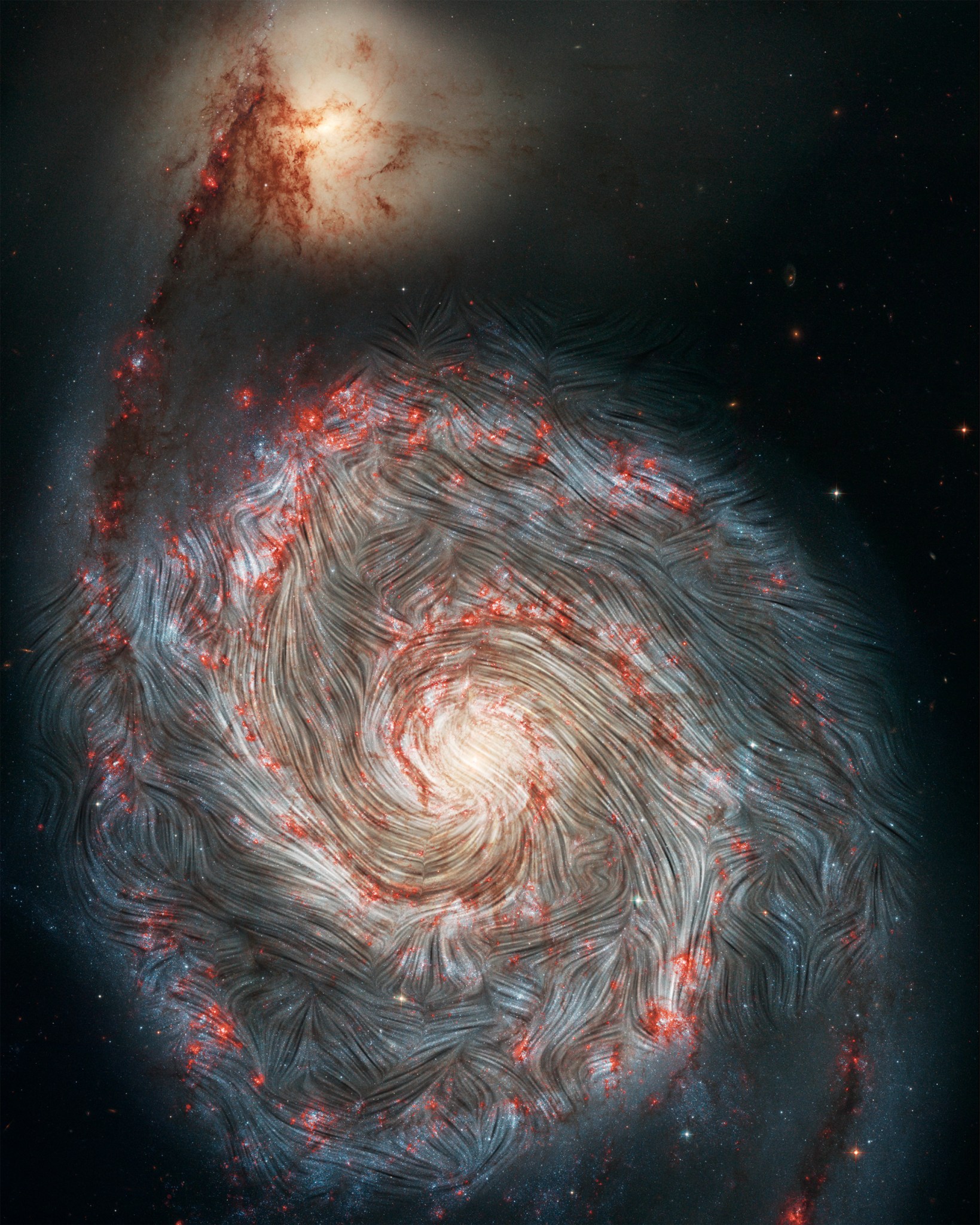
Not all appears as it would seem in the Whirlpool galaxy. One of the best-studied spiral galaxies and a delight to amateur astronomers, Messier 51, as it’s officially named, is influenced by powerful, invisible forces.
Located 31 million light-years away in the constellation Canes Venatici, the galaxy’s arms are strikingly visible as they reach out along the central spine structure, displaying swirling clouds of gas and dust that are massive star-making factories. But new observations by NASA’s Stratospheric Observatory for Infrared Astronomy, or SOFIA, presented at this week’s 237th meeting of the American Astronomical Society, shows a more complicated picture.
Radio telescopes previously detected neatly-drawn magnetic fields throughout the length of the galaxy’s massive arms. But under SOFIA’s infrared gaze for the first time those lines give way to a chaotic scene in the outer spiral arms. Using a far-infrared camera and imaging polarimeter instrument called the High-Resolution Airborne Wideband Camera, or HAWC+, researchers found that the magnetic fields in the outskirts of the galaxy no longer follow the spiral structure and are instead distorted.
What’s causing all this magnetic pandemonium? The intense star formation in these areas creates chaos that can only be seen with infrared flight. A nearby, yellowish galaxy called NGC 5195 tugging at the outermost tip of one of the arms adds to the turmoil, possibly strengthening the magnetic fields. The research builds on SOFIA’s previous findings that show magnetic fields are important in shaping spiral galaxies and helps unravel the complex role magnetic fields play in the evolution of galaxies.
NASA’s Lunar Instruments ‘Shake Hands’ with Commercial Moon Lander
by Frank Tavares
NASA is preparing to send three new water-hunting science instruments to the Moon as payloads on the first lander flight by Astrobotic through the Commercial Lunar Payloads Services, or CLPS, initiative.
As preludes to NASA’s Volatiles Investigating Polar Exploration Rover, targeted to launch in 2023, these versions of the VIPER instruments will study what happens when Astrobotic’s Peregrine lander touches down this year on the northern region of the Moon and blasts water exhaust and other residue across the lunar surface.
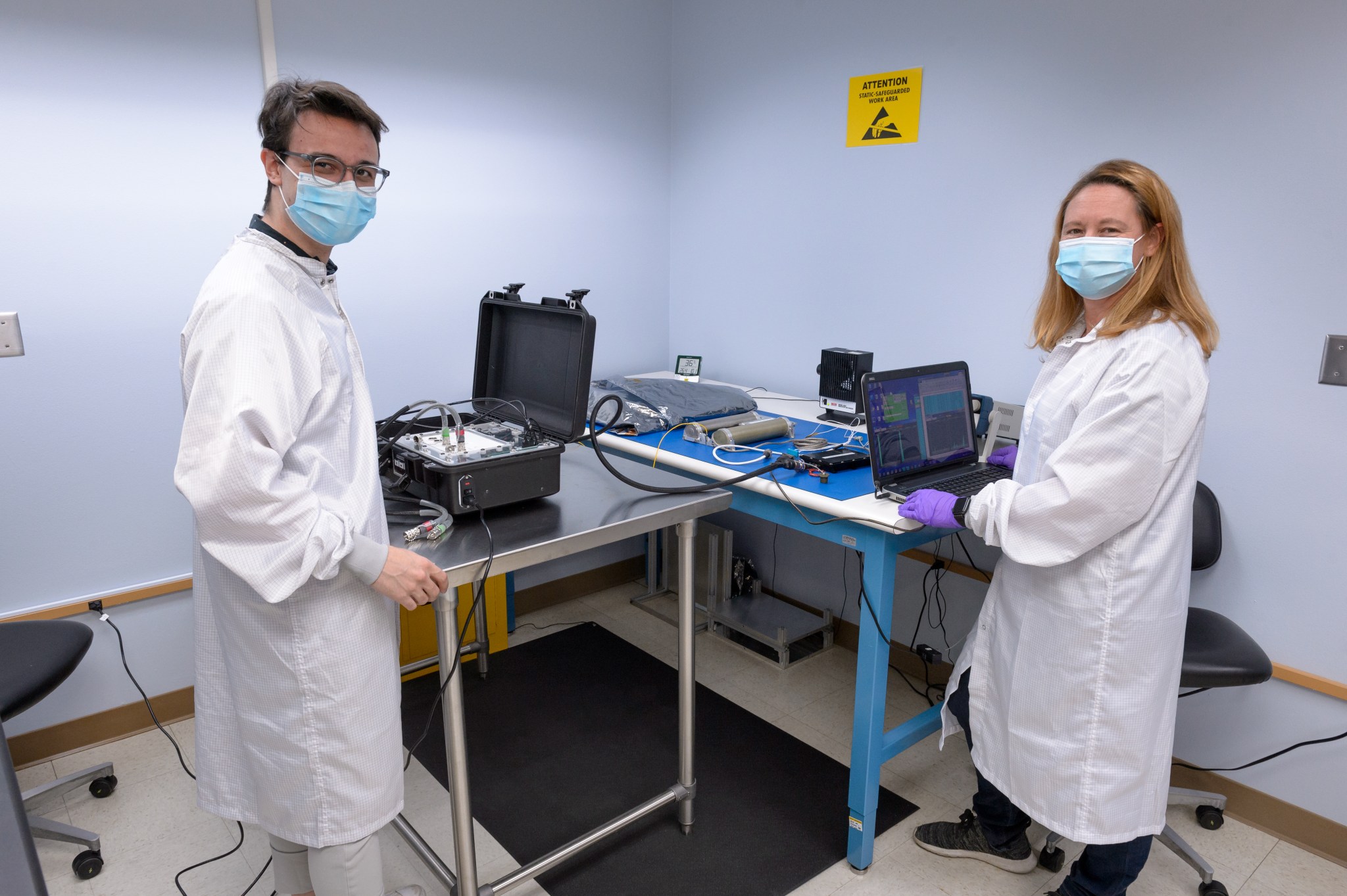
Members of the NASA instrument teams recently worked with Astrobotic to complete a series of end-to-end tests between the instrument hardware and systems simulating the lander. The test set out to verify that the power, data, and software interfaces between the instruments and the lander are working properly. The Payload Interface Mobile Simulator, or PIMS, tests were conducted at NASA’s Ames Research Center in California’s Silicon Valley and the agency’s Kennedy Space Center in Florida as one of the final steps before the flight instruments are integrated onto the Peregrine lander.
“These tests are a first handshake between our instruments and the lander’s systems to make sure we can successfully collect the data we want to get on the Moon,” said Amanda Cook, the lead integration and test engineer for the Near Infrared Volatile Spectrometer System, or NIRVSS, instrument at Ames.
The instruments include NIRVSS and the Neutron Spectrometer System, or NSS, as well as the Mass Spectrometer Observing Lunar Operations, or MSolo. Complimentary payloads will also be attached to the lunar lander, and able to provide datasets to confirm and compare results from the VIPER instrumentation set. A total of 11 NASA payloads will be delivered to the Moon on Astrobotic’s lander. Another company, Intuitive Machines, is also delivering NASA payloads to the lunar surface this year.
The three instruments are designed to work in synergy. Attached to the exterior of the Peregrine lander, they will have a close-up view of the lunar surface after the lander’s propulsion system sprays the ground during landing. Peregrine’s propulsion system creates water and other residue such as carbon dioxide and hydrocarbons. With these materials introduced in a controlled manner on the surface of the Moon, it sets up an experiment for scientists to study what happens when they’re released to the lunar environment by natural means. That information about how these materials travel across the lunar surface is key to understanding the history of the water cycle on the Moon and the pathways that lead to the trapping of water at the poles.
Over the course of several days and with dramatic swings in temperature, the study will provide clues as to how water molecules travel across the lunar surface. The shadow of the lander will be closely observed as the instruments watch how water molecules collect there as a proxy for the naturally occurring cold, permanently shadowed regions of the Moon. The study also will inform how much contamination of the surface occurs during landing activities – important information for lunar exploration efforts like VIPER.
“We expect to see some of the water go away as sunlight heats the area up – but how much water sticks to grains of lunar soil on the surface is a key answer we don’t know yet,” said Anthony Colaprete, VIPER’s project scientist. “The water molecules may bounce off and hop around the surface until they’re destroyed, or we might see them collecting in the lander’s shadow. That would help us understand the pathways that bring water to the poles.”
That science will all be made possible by the integration of NASA instruments with Astrobotic’s Peregrine lander. Because of the rigorous PIMS testing, both NASA and Astrobotic are prepared to further our understanding of the Moon together.
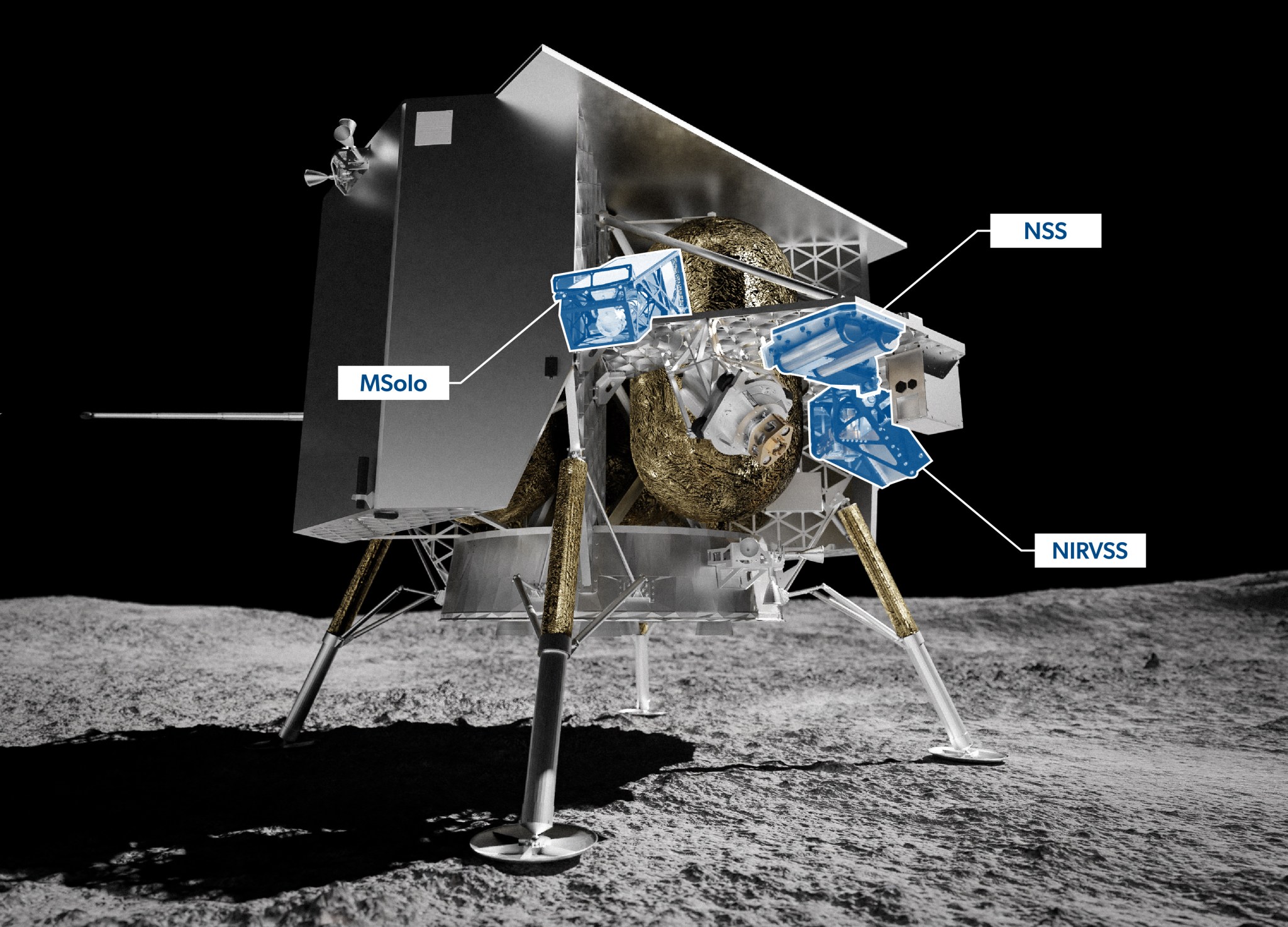
Former Director of the Office of Space Research Joseph Sharp Passes Away
Joseph Cecil Sharp II, 86 years old, passed away Jan. 13, 2021 peacefully in the night while sleeping. He was born in Salt Lake City, Utah, on May 30,1934 to Helen Swenson and Cecil Sharp. He was married and sealed for eternity to Pauline Burnham in the Salt Lake City, Utah temple on June 7, 1956.
Growing up, he lived in Salt Lake City, Utah; Seattle, Washington; Syracuse, New York, and Logan, Utah. After high school, he was awarded a swimming scholarship to the University of Utah where he met Pauline, his future wife on a blind date. His schooling was interrupted when he was drafted into the army for two years where he served in the infantry, artillery, and trained as a medic. After his service, with help from the GI Bill, he dropped his scholarship, married Pauline (“the smartest thing I did in my life”), and focused on obtaining a bachelors and then masters degree in physiological psychology followed by a PhD in neuroanatomy and physiological psychology. Joe’s daughter, Cindy Sharp Stephenson, was born while he was wrapping up his graduate work.
Upon graduation, he was commissioned as an Army officer and worked at the Walter Reed Army Institute of Research in Washington D.C. His son, Joe, was born while he was working at Walter Reed. He was involved in cutting-edge research valuable to the security of the nation. He spent more than a year in Vietnam where he “got involved in the intelligence community.” After leaving Walter Reed, he moved to California and worked at NASA Ames Research Center where he retired as the director of the Office of Space Research. He worked at Ames approximately from 1974 to 1994.
Upon retirement, he and Pauline moved to Southern Utah and his time was spent teaching at Southern Utah University, volunteer work (for more than nine years with St. George Police department), learning to fly and buying an airplane, and enjoying his family.
His unique experiences were always in the service of the nation he loved. Family and friends marveled at his stories. He did groundbreaking research on microwaves; he studied the effects of radiation on animals and people; he pioneered training dogs to sniff for drugs (and the Viet Cong); he trained dolphins and birds for classified missions; he traveled to the Antarctic to study immunology in isolated populations; he supervised and coordinated numerous experiments on the space shuttle and space station; he played an important role in the Soviet US space program; and on numerous occasions, he saved lives in accidents or combat with his medical experience. Always in the service of the United States of America.
He is proceeded in death by his wife Pauline and his brother Albert (Bump) Sharp. He is survived by his children, Cindy and Bob Stephenson of Spring City, Utah and Joe and Debbie Sharp of Highland, Utah; eight grandchildren and 17 great-grandchildren, as well as his brothers Merv and Steve Sharp.
He had a brilliant mind and learning was instrumental to his character. He was taking graduate-level classes as recently as several months ago. He also learned to be a grateful, humble, loving and caring husband, father and grandfather. His mantra for the last several years of his life was, “can you believe how blessed we are?”
A graveside service will be held on Jan. 20, 2021 at 12:30 p.m., at the Tonaquint Cemetery, 1777 S. Dixie Dr., Saint George, Utah.
In lieu of flowers, please make a donation to the law enforcement support organization of your choice.




























